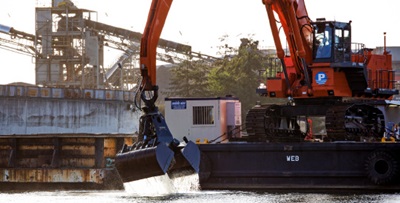Sediment management plan
Information about King County’s Sediment Management Plan (SMP) to address historical sediment contamination near County combined sewer overflow (CSO) outfalls.
King County's Wastewater Treatment Division is addressing sediment contamination near County CSO outfalls in Seattle through a Sediment Management Plan. The plan was developed in the late 1990s and updated in 2018 to reflect data from more recent studies. The County is investing tens of millions of dollars in cleaning up these contaminated areas.

Placing clean cover material
The 1999 SMP evaluated remediation strategies for correcting hazards caused by contaminated sediments near seven King County combined sewer overflows (CSOs). These seven sites were identified when the Department of Ecology’s published its Confirmed and Suspected Contaminated Site List that first contained aquatic sites in the 90’s. The plan also addressed ways to evaluate and rank other areas of contamination that may be identified in the future.
The 2018 SMP Update identifies appropriate sediment management strategies adjacent to each remaining King County CSO outfall location. Sediment quality at other facilities is evaluated on a case-by-case basis in separate reports. This SMP update describes King County CSO discharge locations, summarizes ongoing and previously performed sediment cleanup work, and summarizes the results of CSO solids deposition modeling and existing sediment quality in the CSO discharge areas. This SMP update also evaluates alternative sediment cleanup options for the University Regulator Station (RS) Overflow area to incorporate potential cost implications of any cleanup required at the site into long-range planning.
Sediment Management Plan 2018 Update, September 2018
Sediment Management Plan, June 1999
Sediment Management Plan Task 1400 Technical Memorandum, June 1999
This document identifies and evaluates programmatic long-range remediation alternatives for consideration at seven identified sediment cleanup sites near King County combined sewer overflow (CSO) outfalls. By completing this planning-level evaluation, King County is not claiming responsibility either in full or in part for the existing sediment contamination. Rather, this information can be used by King County and other parties to evaluate the range of cleanup options available for specific sites within Elliott Bay and the Duwamish River.
The information presented here for each site was initially developed as a series of technical memoranda that evaluated:
- screening level recontamination modeling (Task 900);
- evaluation of sediment remediation technologies (Task 1000);
- review and development of sediment site prioritization (Task 1100);
- analysis of programmatic sediment remediation alternatives and strategies (Task 1200);
- and identification of cooperative project and funding opportunities associated with the sediment cleanup sites (Task 1300).
The information contained within the various technical memoranda, including several additional work products prepared by King County, have been assembled into this Sediment Management Plan (SMP).
- Sediment Impact and Recovery Zone Models Review and Development Task 900 Technical Memorandum, May 1999
- Preliminary Review of Sediment Remediation Alternatives
Task 1000, January 1999 - Sediment Prioritization Criteria Technical Memorandum
Task 1100, January 1999 - Sediment Remediation Alternative Evaluation
Task 1200 Technical Memorandum, February 1999 - Cooperative/Demonstration Project Opportunities
Task 1300 Technical Memorandum, April 1999 - Review of Federal and State Laws, Regulation and Standards
King County Task 2 Technical Memorandum, December 1998 - Literature and Project Review
King County Task 3 Technical Memorandum, May 1999 - Review/Analysis of Previous/Current/Future Actions & Coordination with Related Projects
King County Task 4 Technical Memorandum, December 1998 - CSO Sampling and Monitoring Data Inventory
King County Task 5 Technical Memorandum, August 4, 1998 - Identification of Nearby Contaminated Sites
King County Task 6 Technical Memorandum, Dec. 1, 1998

 Translate
Translate